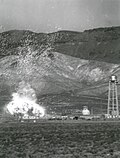Nuclear thermal rocket
| Advanced search |
- About 8 results found and you can help!
 1st December 1967: The first ground experimental nuclear rocket engine (XE) assembly, is shown here in "cold flow" configuration, as it makes a late evening arrival at Engine Test Stand No. 1 at the Nuclear Rocket Development Station, in Jackass Flats, Nevada. |
In a nuclear thermal rocket a working fluid, usually liquid hydrogen, is heated to a high temperature in a nuclear reactor, and then expands through a rocket nozzle to create thrust. In this kind of thermal rocket, the nuclear reactor's energy replaces the chemical energy of the propellant's reactive chemicals in a chemical rocket. Due to the higher energy density of the nuclear fuel compared to chemical fuels, about 107 times, the resulting propellant efficiency (effective exhaust velocity) of the engine is at least twice as good as chemical engines. The overall gross lift-off mass of a nuclear rocket is about half that of a chemical rocket, and hence when used as an upper stage it roughly doubles or triples the payload carried to orbit.
- Related: In-situ resource utilization, NERVA, Nuclear pulse propulsion, Project Pluto, Project Rover, Project Prometheus, Project Timberwind, Spacecraft propulsion, UHTREX
| Dumbo (PDF) Dumbo (PDF) www.dunnspace.com/00339489.pdf - Web |
| picture of the EX' engine picture of the EX' engine www.f104g.demon.co.uk/space/nerva1.htm - Web |
| Rover Nuclear Rocket Engine Program: Final Report ... Rover Nuclear Rocket Engine Program: Final Report - NASA 1991 (PDF) ntrs.nasa.gov/.../19920005899_1992005899.pdf - Web |
Gallery for «Nuclear thermal rocket»
Average relevance
| Neofuel Proposal for steam-based interplanetary dr... Neofuel Proposal for steam-based interplanetary drive, using off-earth ice deposits www.neofuel.com - Web |
| Project Prometheus: Beyond the Moon and Mars Project Prometheus: Beyond the Moon and Mars prometheus.jpl.nasa.gov/index.cfm?pageL1=homePage - Web |
| Nuclear propulsion Nuclear propulsion www.bernd-leitenberger.de/nukleare-antriebe.shtml - Web |
| RD-0410 USSR's nuclear rocket engine RD-0410 USSR's nuclear rocket engine www.astronautix.com/engines/rd0410.htm - Web |
| Soviet/russian solid core nuclear rocket engine Soviet/russian solid core nuclear rocket engine www.novosti-kosmonavtiki.ru/content/numbers/218/58.shtml - Web |


